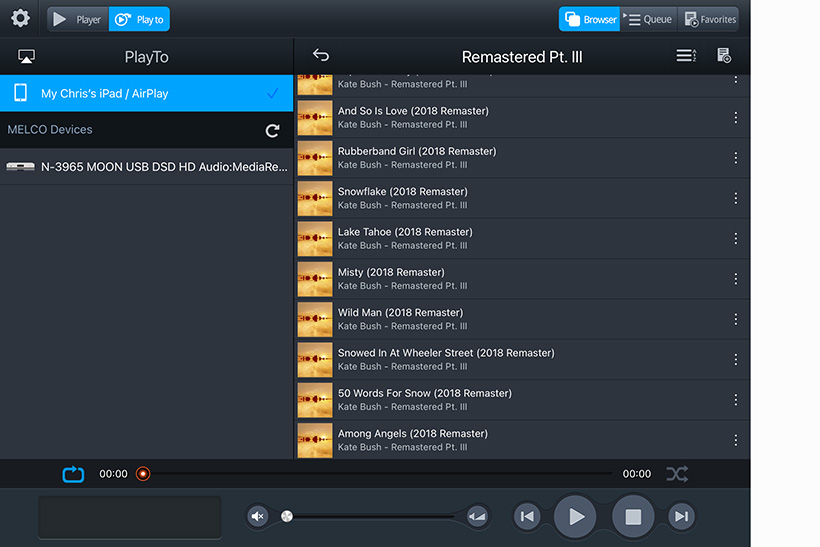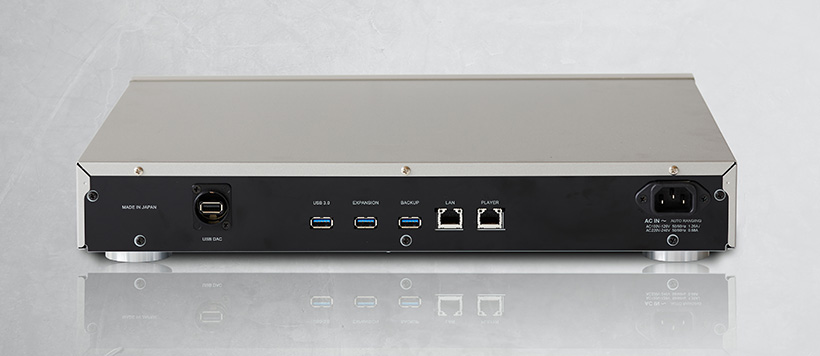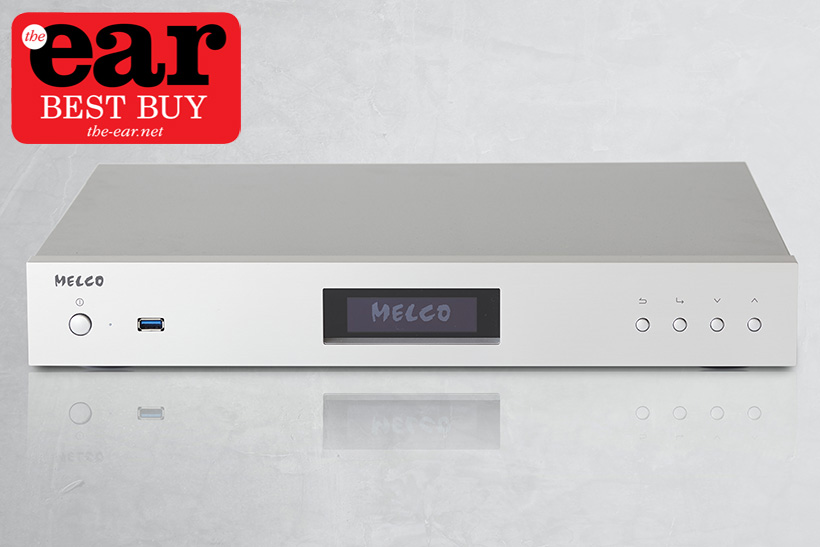Melco N50-H60 music library
The freshly launched N50-H60 replaces the NA1/2EX and joins the N50-H38, an SSD variant in the same chassis. Confusingly, the new model uses the same casing and switchgear as its predecessor, the only apparent external change being the upgraded feet which are said to have improved vibration feedback control. It may surprise many that an audio server, fed by a hard drive, is susceptible to vibration at all. Still, one of the main features that has given Melco servers their edge over the competition has been the way they mount their drives to avoid such disturbances. That, along with Melco’s obsession with reducing all sources of noise and, of course, clock accuracy. The NA1/2 evolved into the NA1/2EX a couple of years ago.
Whilst there are other manufacturers of high-quality audiophile servers, Melco is probably the only brand that is part of a group that includes a major manufacturer of computer components. Which gives them an edge over the competition. Buffalo Technology is said to have invented the first printer buffer and has been at the forefront of IT ever since. My journey with their products goes back around five and a half years, having been clear from the start that I did not want to use a computer in my hi-fi system, the original Melco NA1 music server was the product that convinced me that time was right to migrate to a file-based audio system. A short demo against its natural competitor was all I needed to part with my money and purchase the newly launched NA1/2, I have not looked back since.

The NA50-H60 takes advantage of a few things Melco have developed for their more expensive models, making these benefits available at a lower price point. The entry level Melco models have always used high-quality SMPSUs (switch mode power supplies), with the top-of-the-range units containing LPSUs (linear power supplies). Alan Ainslie of Melco’s Distributor, ADMM, tells me that SMPSUs can be built to produce very low noise, but they have to be designed correctly. Melco claims that the power supply fitted to the N50-H60 produces 25% more power than the PSU fitted to the N1A/2. Along with the aforementioned new feet, a new HDD mounting is said to offer greater isolation from external vibration.
Features and build
As previously mentioned, the casing of the N50-H60 is the same as that of the N1A/2, which means a typical 43cm wide box that’s available in either black or silver. The ‘60’ part of the moniker denotes that a 6TB hard drive is fitted. You can expand the storage via an external drive connected via a USB port at the rear of the box. Melco produces the E300, 3TB drive for this purpose, which will give better performance than a standard computer peripheral hard drive. There is also a backup port at the rear of the machine, allowing you to back up and restore your music, always keep a back up. All Melco units in the current range use the same operating system and software. Hypothetically, the N50-H60 has identical ergonomics to the N1A/2EX that it replaces, yet I found it to be noticeably more responsive, with none of the lag I experienced the NA1/2 since it was new. The N50-H60 is also noticeably lighter than unit it replaces, although I could not find the respective weights.

Since the introduction of the EX upgrades, owning a Melco became much simpler, the key upgrades being the addition of Minimserver 2 and SongKong for Melco. Minimserver 2 is a powerful piece of software that allows you to set up categories for your collection, which can be especially beneficial to users with large classical collections. SongKong makes easy work of tagging your music and can be a godsend for those importing large libraries, perhaps from computers or servers from other brands. Naim machines, for example, store the metadata on a separate file, rather than inside the music files themselves which means that a library tagged on a Naim server has to have metadata added before things like artwork will be visible on another machine, which is time-consuming experience without software like Songkong.This is also available for home computers, but having it on your server makes it possible to manage your Melco library without the use of a computer. You can login into Songkong and Minimserver via a web browser, from any phone or tablet on the same network as the Melco. Logging into the former allows you to edit your library, update artwork etc. You can also operate the latest machines remotely via the web portal, which I have found helpful if I want to run a backup or another function while in a different room to the system. You can control the N50-H60 via any UPnP App, although Melco does produce its own.

The Melco range can play music via a high-quality USB output, or over the isolated ‘Player Port’ via ethernet. Since I discovered the delights of the ENO ethernet filter and cables, I have accessed my music via the latter, using the Moon MiND App. All of the latest Melco machines can be used as Roon endpoints, so many choose to access their Melco library and control their machines in this way. The Melco servers can also stream from the cloud, the services on offer are limited only by the app you use to control it, although Tidal users should note that there’s no native MQA compatibility. One of my favourite features has always been the downloader. This allows you to sync music downloaded from both Qobuz and Highresolutionaudio.com, so that all purchased music automatically downloads to the Melco. I have always loved making a purchase and having the music available to play within just a few minutes. Importing music can be carried out directly via a USB slot on the front panel. This is preferable to doing so over the network for several reasons, not least because your music is then scanned via Songkong when you transfer it, which helps ensure it is properly tagged. The Melco range can both rip and play from almost any ‘plug-n-play’ CD drive. However, I would highly recommend doing so via Melco’s D100 drive, which ensures your rips are as close to bit perfect as possible and, in addition, makes for a wonderful sounding CD player.
Sound quality
Using a high-quality server, rather than a computer, ensures that your DAC gets a cleaner signal with lower noise. From my early comparisons, I found the Melco range offers an extremely spacious sound, with more sense of dimension than the similarly priced competition. With a Melco as the source, I find CD rips sound better than all but the very finest CD players I have heard. I have purposely avoided trying out one of their top-end machines at home. Especially as I know, Jason Kennedy made the costly ‘mistake’ of reviewing their N10 machine, which is now in his system permanently.

Comparing the N50-H60 to my NA1/2 machine has shown me which aspects have been improved upon. With the N50-H60, it was immediately apparent that I was listening to music via an electrically quieter source. Thankfully, from the perspective of my bank balance, such differences are not of night and day proportions, but they are obvious to hear. The music is delivered with greater clarity and is a little more detailed. The detail is most evident at the lower end of the dynamic range. In certain recordings that are relatively quiet, for example Nils Frahm’s Spaces in 24/44, the music emerging from a quieter background, with the quietest parts appearing to sound more defined and with higher resolution. Kate Bush’s 50 Words for Snow in 24/44, benefited in the same way. The high frequencies were a little cleaner in general, an example being a CD rip of Massive Attack’s Better Things from their second album Protection, I could hear the reverb on Tracy Thorn’s vocals a little easier, and the electronic hi-hats were more defined and precise. I also felt the soundstage was better defined and that it was slightly easier to hear the sense of acoustic of well-recorded music. This helped me to enjoy my collection of Dead Can Dance SACD rips even more than usual. Compared to the model it replaces, the new machine has no sonic drawbacks, and all improvements are musically beneficial.
Conclusion
In the N50-H60 Melco have made evolutionary updates over the N1A/2, which should help maintain their sonic superiority over the competition at its price point. There have been some interesting new arrivals to the marketplace over the last few years, with offerings from Innuos among others pushing the quality of servers in this sector. While it is fair to say that Melco’s products will suit those audiophiles who are a little more tech-savvy, the EX updates have broadened the brand’s appeal considerably. I feel confident that with the N50-H60, Melco has cemented its position as the manufacturer of the best-sounding server for sensible money.


